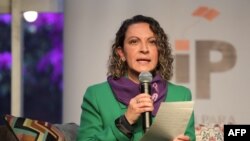Journalism is a dangerous job. Over the weekend, journalists in the Philippines and Mexico were killed, and a third survived a shooting in Afghanistan.
The deaths will be added to a toll of more than 400 journalists whom UNESCO says have been killed globally since 2016, often without anyone being held accountable.
Impunity in those cases creates an environment that emboldens would-be attackers. Lack of action over the deluge of violent threats that target journalists online globally has the same effect, experts say.
The impact of that can bring serious repercussions, said Guy Berger, director of freedom of expression and media development at UNESCO. "Journalists are serving society, and at a time of disinformation, their contribution is really important," he told VOA.
As part of events to mark the U.N. International Day to End Impunity for Crimes Against Journalists on Tuesday, a panel moderated by Berger looked at the issue of digital threats to women, and how policymakers, politicians and newsrooms can put a stop to impunity.
One of the speakers, Columbian journalist Jineth Bedoya Lima, told the panel that "Sexism is being used to silence the voices of women."
The investigative journalist and women's rights advocate has been targeted for her work, including a 2000 attack in which she was abducted and sexually assaulted while on assignment. It is a crime that the state only recently took responsibility for. The Inter- American Court of Human Rights ruled in October that by failing to properly investigate, Columbia had violated Bedoya's rights to justice and protection.
Women's voices are vital in journalism, acting as "a lifeline between marginalized communities and the world," Bedoya said.
But, she added, online harassment is becoming one of the worst issues for female journalists.
Global problem
The extent of the problem was revealed in a joint report by UNESCO and the International Center for Journalists released in April that surveyed 901 journalists identifying as female, in 125 countries.
The survey found 73% of respondents had experienced some form of online harassment. Threats of physical violence, sexual violence and violence against family members were among the most common attacks.
"Social media is serving to amplify anger," said Berger. "A lot of these women are attacked because they're journalists, but in addition to that, because they are women journalists. That seems to inflame the attackers even more because, presumably, their view is that women should not be doing the work of journalists."
Silvia Chocarro, head of protection at Article 19 — an advocacy group defending freedom of expression — told VOA that online harassment is often not taken as seriously as other threats, but its impact can be just as powerful. Chocarro was also a panelist at Tuesday's event.
"Online harassment against women, it is real. You can feel it physically, you can feel it psychologically," Chocarro told VOA.
In the UNESCO study, 12% of women surveyed reported seeking medical or psychological help because of the effects of online violence. As many as 20% experienced online threats that led to offline violence. A journalist's race, gender or sexuality was often used in the digital attacks.
Online threats and hate speech are beyond the protection of freedom of expression, Berger told VOA. "These are not just criticisms, these are death threats, rape threats, threats against family. … You don't have the freedom to threaten people with those kinds of consequences because you disagree with them."
It becomes the responsibility of those targeted to take action to protect themselves, but newsrooms often lack the organizational support to help colleagues.
The survey found that journalists in only a quarter of cases told their managers they had been threatened. Those who did report threats said they were often told to "toughen up" or asked what they had done to provoke the attack.
"When we talk about violence against journalists," Chocarro told VOA, "it's always about what happens outside, and I really think when it comes to women, we have to start to talk about what happens inside.
"The reality is that in most of the world, women are not even safe where they are supposed to be safe, which is in their own newsroom," Chocarro said.
Support network
Khadija Patel, head of programs for the International Fund for Public Interest Media and the former editor-in-chief for South Africa's Mail & Guardian newspaper, described feeling powerless when dealing with online harassment against herself and women in her newsroom. Colleagues from around the world advised her to just ignore the attacks, she told the panel.
"Online harassment directed at journalists as individuals represents an attack on the entire newsroom," Patel said. "The acknowledgement of this is essential in building a strategy to combat online harassment."
Steps can be taken to reduce online harassment and make it easier for those targeted to report what is happening, Article 19's Chocarro said.
These include government policy, public condemnation of online harassment from politicians, training for police on how to handle complaints, better content moderation on social media platforms and clearer instructions for how to report harassment online.
Berger told VOA that addressing threats against journalists both on- and offline is vital.
"When journalists are killed or intimidated online, or intimidated by the killings of other journalists, it's one less voice that's contributing verified, credible information at a time of disinformation and hate speech," Berger said.
"We really need as much journalism as we can get, and the more that journalists are not safe, the more that societies will suffer," he added.
Editor’s Note: This article has been updated to clarify that the study cited in paragraph 10 was a joint project by UNESCO and the ICFJ.




